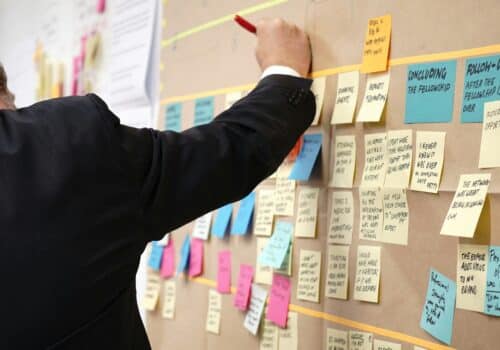August Connections video: What got you here won’t get you there
When you’re on your second round of ERP selection and implementation, you might think, “Well, we’ve been there, done that — this should be similar to the last time we tackled this.”
But with many of our privately held, mid-market manufacturing clients, they discover that the second ERP round is completely different from the first. A team of 1 or 2 people pulled off the first implementation without breaking a sweat … but the second round will be a whole different story.
After all, your business is more complex. You’re growing faster. Your team is bigger.
So today I’ve got a few resources for you that will help you with resource planning for your ERP implementation. First, watch the video where I give you the hard and fast truth about why resource planning is so important.
Then, I’m giving you a few resources our clients have found useful. This is an excerpt of my resource planning presentation that explains the different roles and capabilities you’ll need for your project, and then helps you assess your current resources and figure out where your gaps are. Use this Excel spreadsheet to help you work through your resource gap planning.
Next, I’m giving you a powerful tool that will help you get clear on the people, processes, and technology you’ll need for your next round of ERP: Download the ERP Readiness assessment here.
Hopefully these resources will be helpful as you’re kicking off conversations with your leadership about the realities of your ERP implementation project.
Hi, Erin Koss here, CEO from Syte Consulting Group, I want to talk today a little bit about companies, and specifically, family-owned manufacturing companies that might be on their second round of ERP selection and implementation. Something that we see often is you’ve been there before. You’ve done it before, and people tend to think that it’s going to be the same experience the second time around. We want to caution our family-owned manufacturing clients that it may not always be the case. The saying “what got you here may not get you there” Is true in this case.
Let me paint the picture for you. Let’s say 5, 10, or even 15 years ago, you were implementing your first ERP solution. It might have been a Mass 90, a Great Plains Solomon, maybe even a Microsoft NAV or Division at that time. Something smaller, right? You were able to do that with one or two people. Remember, your company at that time was a lot smaller, a lot less complex and probably wasn’t growing at the rate that it is now, which is prompting this next round. Often, what we see is companies trying to go about it the same way they did before with those same people. They realize that the effort is far bigger than they expected and unfortunately, they get a year or two years into the process and realize they’re maybe in over their heads.
What I want to talk to you about today is how to avoid that from the very beginning. Maybe even share with you some resources that we use that our clients have really appreciated to help them have the conversation about resources and capacity planning as early as possible. When we’re asked to the party, so to speak, we usually start out with what we call a measurement, an assessment prior to even doing the evaluation, selection and ultimately, the implementation. During that time, we’re working with our clients to help assess what kind of capabilities and capacity do they have at their fingertips within their organization today. Now, we know that family-owned businesses are lean and mean, right? They are doing a lot with as few people as they need because that’s the way it works.
Those people have been there a long time and they’re highly valued and they are busy in their day jobs. To ask them to spend time on a special project, much less a large project like an ERP implementation can be tough to do. It can be a big ask. What we want to do is have those conversations early but also start to give some to share with you today. Some ways to think about when you might make sure you have to have those resources that are your internal resources.
When outside or outsourcing certain roles, it might be better to consider back selling those resources as well. These are the ones that maybe you take out of your own organization. Are you going to just lend them to the project or are you going to entirely backfill them? I suppose the thing I want to talk about today is the recognition that the folks that are going to be needed on the project. Those folks from your internal resources.
You need to know who they are and what their skills need to be. We find some of the most important things for those folks includes a good understanding of your business and your culture. You need to know their key function in the business that they support. I think those are the three things that are most important.
The challenge, of course, is those are also some of your most valuable folks. By asking them to be available for around 50% of their time for basically a year to do an ERP implementation (and maybe longer!) is very difficult. We encourage our family-owned businesses to really look at those folks hard because those are roles that are critical subject matter experts before you bring in an outside consulting firm. Backfilling those roles on a project team is not ideal for your company during or even after. It just delays the fact that you maybe just need a few more people or need to find a way to maybe backfill them temporarily and free them up for the project.
Playing those roles and having outsiders play those roles is usually not the best play. There are some key roles like project management and business or technical analysts that can be helpful to getting from the outside because those folks are built to do just this. These projects have the ERP experience and have the broad business background to partner with you to make sure to keep the solution providers on the straight and narrow. The solution providers are there to focus on the solution. You need them, you want them, and we love them for that. They do tend to get in a vacuum when they’re thinking sometimes because they are focused on helping you set up configure and implement that solution. Sometimes, the culture, broad business, and strategic aspects of the business are less of their focus.
As an example, a firm like ours is going to be equipped to be the glue between the two pieces and the expertise that you bring to the table. Let me fast forward to the tool that I want to share with you today, which is this tool and capacity planning. You’ll see that we have a presentation here. I’m going to share this in this post, and I hope it’s valuable to you. I’m not going to run through all the slides here today but suffice to say it’s probably worth a look as well as sharing with your leadership team and using it as a conversation starter for planning for your own staffing of an ERP implementation.
Let me say again, the way you did this the first time just is not going to necessarily help you at this place. If you’re that much bigger and more complex than you were the first time. It’s going to take a village, so to speak. With that, I want to point out this one slide here and this is slide four. This is a helpful tool, at least our clients have told us this, that goes through and explains the different roles, capabilities, and capacity. What roles, capabilities, and what describes them also helps you have a conversation about who do you need, how much are you going to need them on an ERP project, and then should they be internal, or could they be external? They’ll give you some food for thought. The following slides are also sort of helpful.
You’ve got this here that gives you a picture of maybe internal and external, a little different view. But then lastly, there is a table that you can make your own. And so you take this table and you start to really plug in the people, the who on your team would play these different roles and do they have the capacity? And so you start to build a map of where are your gaps in capacity. So with that said, I encourage you to consider using this as a tool to have a great conversation with your leadership team about the realities of hey guys, I know we did this this way before.
It’s probably not going to be looking like that’s possible this time. Here’s why. Heck, show them our video from today, right? And here’s a tool to help you do some planning. One other tool that we’ll include in today’s video is one that we call our ERP Readiness Assessment.
This PowerPoint focused exclusively on resource planning. The ERP Readiness assessment focuses on the process preparation that is important as well and the technology side of things. It’ll cover people process and technology and it could be just another additional resource for you that might be helpful in the process. With that, I wish you all the best in doing your planning for your next round of ERP.
If you need help in making some of those decisions and having some of those conversations and doing that planning, please don’t hesitate to reach out and give me a call. I’d love, love, love to chat with you about it. Take care.
ERP Readiness Self-Assessment
Is your organization ready for a new or upgraded ERP solution? Find out with this complimentary self-assessment.
Doing Business Better
You strive for excellence, believe in your people, and want to do things right the first time. And you know that you need help to get to the heart of your business challenges and make the best choices for the future of your privately held manufacturing and distribution company. That’s where we come in.
We help you focus and find exactly the right path to accelerated growth and sustainable success — from your people to your processes to your ERP software.



